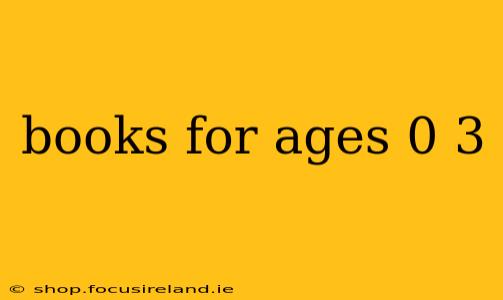Choosing the right books for your little one can feel overwhelming. The world of children's literature is vast, but selecting age-appropriate books that stimulate development and foster a love of reading is crucial for a child's cognitive and emotional growth. This guide provides curated recommendations for babies and toddlers aged 0-3, categorized for easier navigation. Remember, reading aloud, even to the youngest of children, is an invaluable investment in their future.
Board Books: The Perfect Introduction to Reading (0-18 Months)
Board books are the unsung heroes of early childhood. Their sturdy construction survives the enthusiastic (and sometimes messy) handling of tiny hands. Look for books with:
- High-contrast images: Babies respond well to black and white, or highly contrasting colors, before their color vision fully develops.
- Simple shapes and patterns: These help babies develop visual recognition skills.
- Repetitive text: Predictable patterns in language help babies start to understand the rhythm and flow of language.
Top Picks:
- "Black and White" by DK: A classic for its simple, high-contrast designs.
- "Baby's First Book" by Roger Priddy: Features a variety of textures and flaps to engage little ones.
- "Dear Zoo" by Rod Campbell: An interactive lift-the-flap book that's a delight for toddlers. (While technically aimed slightly older, the simple concept works well even for younger babies).
Cloth Books and Sensory Books (0-18 Months): Engaging Multiple Senses
These books offer more than just visual stimulation. They often incorporate different textures, sounds, or crinkly pages to engage multiple senses, promoting development in various ways. Choose books with:
- Soft, textured materials: These provide tactile stimulation and comfort.
- Crinkly pages or elements: The sound of crinkling adds an auditory element to the experience.
- Quietly engaging textures: Avoiding noisy elements can be helpful for sensory-sensitive children.
Top Picks:
- "That's Not My..." series: These books feature a variety of animals and objects with different textures.
- Sensory books with various materials: Many publishers offer books incorporating ribbons, crinkly paper, and other tactile elements.
Picture Books: Expanding Vocabulary and Imagination (18 Months - 3 Years)
As children get older, their attention spans lengthen, and they start to appreciate more complex stories and images. Look for picture books that:
- Tell simple stories with clear narratives: Stories with a beginning, middle, and end help children develop narrative skills.
- Feature engaging illustrations: Vibrant illustrations capture attention and stimulate imagination.
- Include repetitive phrases or sounds: This aids in language development and memorization.
Top Picks:
- "The Very Hungry Caterpillar" by Eric Carle: A classic for its vibrant illustrations and simple story.
- "Brown Bear, Brown Bear, What Do You See?" by Bill Martin Jr. and Eric Carle: A repetitive and interactive story.
- "Goodnight Moon" by Margaret Wise Brown: A soothing bedtime story.
Tips for Reading with Your Young Child:
- Make it interactive: Ask questions, point to pictures, and encourage your child to participate.
- Use different voices: Bring the characters to life with expressive reading.
- Read frequently: Even short reading sessions several times a day are beneficial.
- Choose books that appeal to your child's interests: Let them pick books from the shelf.
- Create a cozy reading space: A comfy spot dedicated to reading can make it a special time.
Remember, the most important aspect of reading with your child is to make it a fun and enjoyable experience. This shared time nurtures bonding and lays the foundation for a lifelong love of reading. By selecting age-appropriate books and engaging with your child during reading sessions, you're actively participating in their development and laying the groundwork for future success in school and beyond.

